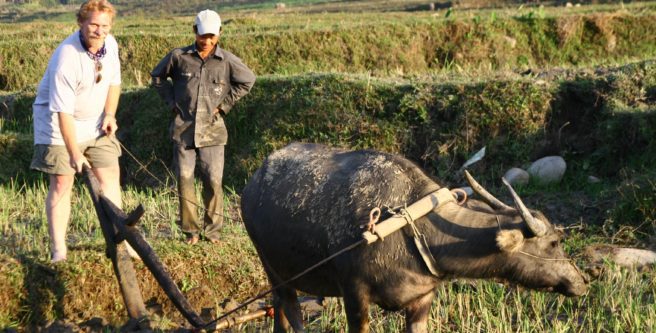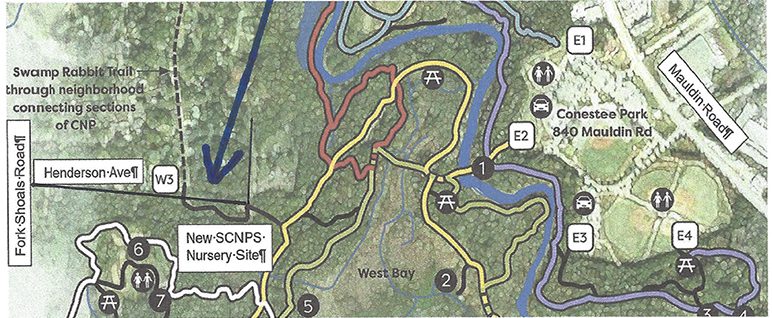an essay by Doug Lockard
“Human activity is driving climate change. If we want to mitigate the worst impacts, it’s going to take a deliberate focus on finding ways to further remove greenhouse gases from the atmosphere.” Colm Sweeney, NOAA’s Global Monitoring Laboratory
NOAA announced recently that carbon dioxide in our atmosphere was recorded at a record-high 421 ppm; about 50% higher than prior to the Industrial Revolution. In fact, they reported, the level of carbon dioxide in the Earth’s atmosphere is now higher than it has been in at least 3.6 million years.
Because soil holds four times the amount of carbon stored in the atmosphere, how we use the land under our care will determine how well it sequesters carbon. Good land stewardship practices that include deep-rooted perennials, woody plants and trees will help sequester carbon in the soil. Native plants are ideal for this purpose as they have the best chance of thriving and long-life in our ecosystems without chemicals or irrigation.
by Doug Lockard, April 2021
The National Oceanic and Atmospheric Administration (NOAA) announced in April 2021 that carbon dioxide in our atmosphere was recorded at a record-high 421 ppm; about 50% higher than prior to the Industrial Revolution. In fact, they reported, the level of carbon dioxide in the Earth’s atmosphere is now higher than it has been in at least 3.6 million years.
“Human activity is driving climate change. If we want to mitigate the worst impacts, it’s going to take a deliberate focus on finding ways to further remove greenhouse gases from the atmosphere.” Colm Sweeney, NOAA’s Global Monitoring Laboratory
Soil holds four times the amount of carbon stored in the atmosphere, and more than is held in vegetation. This means that how we produce and care for soil is just as important as what we grow, and where; modifying agricultural and gardening practices with this in mind is a recognized method of increasing carbon sequestration. Soil can act as an effective carbon sink, offsetting a significant proportion of annual carbon dioxide emissions.
Carbon landscaping implements landscaping practices known to improve the rate at which CO₂ is sequestered. These practices increase the rate at which carbon is taken from the atmosphere and locked away into plant material and/or soil organic matter. Implementation generally involves two key strategies:
- Planting the most effective choices and combinations of plants.
- Maintaining soil to boost carbon capture through the addition of organic material and the avoidance of practices that deplete soil carbon, resulting in overall carbon losses from the land.
The goal is to reduce the carbon footprint of our landscapes to a more natural state by reducing emissions and increasing absorption of carbon dioxide.
How well soil sequesters carbon depends on how land is used.
Turf lawn grass, regrettably, is not particularly beneficial due to its shallow root system. Similarly, annual plants, including most vegetables which are up-rooted each year, also provide little benefit relative to carbon sequestration. In fact, tilling the soil in general releases carbon back into the atmosphere, and is part of the trend for ‘no-till’ practices.
Deep rooted perennials, shrubs and hedges, and trees are well-suited to provide benefit. Many non-native plants will be included in this group, but ‘native’ plants that generally perform better with less maintenance (i.e. fertilizer, irrigation, etc.) will have the highest benefit for long life without disturbance.
Trees play an important role because their size (including large root structures) allow high carbon sequestration year-round. Research has shown that while all tree species absorb CO₂ from planting to old age, they reach their peak in terms of carbon sequestration in their ‘teenage’ years (from 10 to 45 years after planting).
The best strategy is generally to plant a number of different tree species, maximizing shorter- and longer-term sequestration. The best trees to plant will often be those which provide additional benefits to humanity, limiting their likelihood of being chopped down. Trees that can be coppiced (repeatedly cut back to ground level, allowing successive new growth) – meaning that material can be harvested without stopping the trees’ ability to sequester carbon in the root system in future. This way less land can be given over to trees while providing the same overall carbon benefit.
Permanent perennial wood plants (i.e. shrubs & hedges) are vital to carbon-conscious landscapes. Generally, the wider and higher a hedge, the more carbon it will generally sequester. Again, they can be pruned regularly without loss of the carbon captured in the root systems.
Perennial plants with deep roots (i.e. ornamental grasses, milkweed, Baptisia, Butterfly weed, Rattlesnake master, Amsonia, etc.) also help with sequestering carbon, and those with tap roots the most effective. By remaining in place for long periods, deep, woody roots are able to keep that carbon locked below the soil for years to come.



